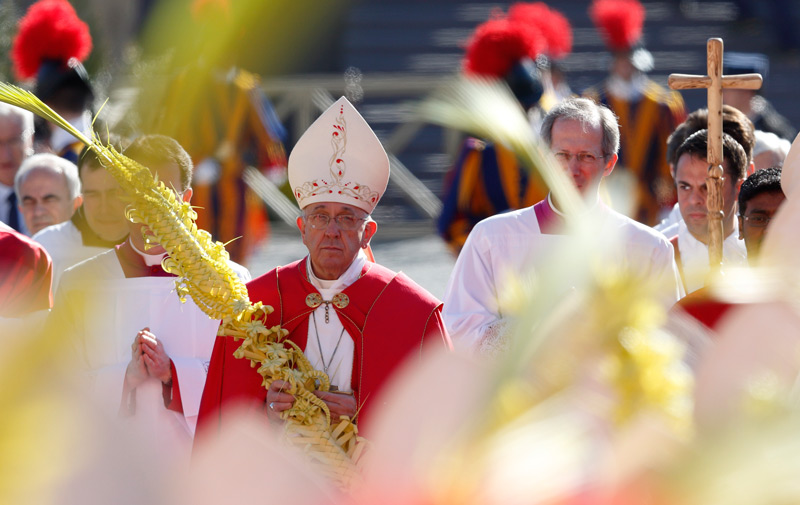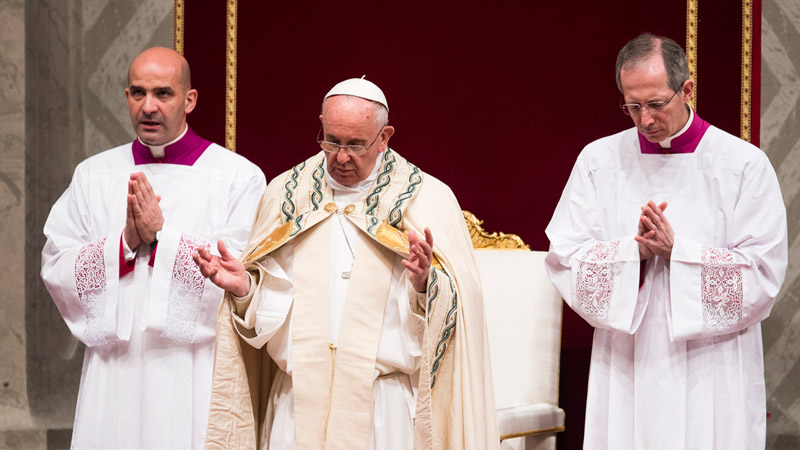VATICAN CITY—Pope Francis will declare Blesseds Oscar Romero, Paul VI and four others saints Oct. 14 at the Vatican during the meeting of the world Synod of Bishops, an institution Blessed Paul revived.
The date was announced May 19 during an “ordinary public consistory,” a meeting of the pope, cardinals and promoters of sainthood causes that formally ends the sainthood process.
During the consistory, Cardinal Angelo Amato, prefect of the Congregation for Saints’ Causes, formally petitioned the pope “to enroll in due course among the saints” six candidates for canonization “for the glory of God and the good of the whole church.”
Each of the candidates, the cardinal told the pope, gave “a convinced and coherent witness to the Lord Jesus. Their example continues to enlighten the church and the world in accordance with the perspective of mercy that your Holiness never ceases to indicate and propose.”
Briefly giving a biographical sketch of the candidates, Cardinal Amato said that during El Salvador’s civil war, Archbishop Romero, “outraged at seeing the violence against the weak and the killing of priests and catechists, felt the need to assume an attitude of fortitude. On March 24, 1980, he was killed while celebrating the Mass.”
Reviewing the facts of Blessed Paul’s life, Cardinal Amato highlighted how, as a high-level official in the Vatican Secretariat of State during World War II, the future pope “organized charitable assistance and hospitality for those persecuted by Nazism and Fascism, particularly the Jews.”
Pope Francis then certified that he had solicited the opinion of the cardinals, who agreed that “these same blesseds should be proposed to the whole church as examples of Christian life and holiness.”
Blessed Romero, the archbishop of San Salvador, was assassinated one day after calling on the government to end its violation of the human rights of El Salvador’s people.
While Catholics inside and outside El Salvador recognized him as a martyr immediately, his sainthood cause was stalled for years as some church leaders debated whether he was killed for his faith or for his politics.
As Pope Francis told a group of Salvadoran pilgrims in 2015, even after his death Blessed Romero “was defamed, slandered, his memory tarnished, and his martyrdom continued, including by his brothers in the priesthood and in the episcopate.”
In February 2015, Pope Francis signed the formal decree recognizing Blessed Romero’s martyrdom; the Salvadoran archbishop was beatified three months later in San Salvador.
The Salvadoran bishops’ conference and many Salvadorans had hoped Pope Francis would preside over the canonization in San Salvador, particularly because of the difficulty and expense of traveling to Rome. Others, however, argued that holding the ceremony at the Vatican makes it clear that Blessed Romero is a saint for the entire church, not just for the church in El Salvador.
Salvadoran Cardinal Gregorio Rosa Chavez told TV2000, the Italian bishops’ television station, that he hoped Pope Francis would make a brief trip to San Salvador in January to pray at the tomb of by-then St. Oscar Romero. The pope will be in Central America for World Youth Day in Panama.
Blessed Paul VI, who was born Giovanni Battista Montini, was pope from 1963 to 1978. He presided over the final sessions of the Second Vatican Council and its initial implementation. He also wrote “Humanae Vitae,” a 1968 encyclical on married love; the 1975 apostolic exhortation “Evangelii Nuntiandi” on evangelization; and “Populorum Progressio,” a 1967 encyclical on social development and the economy.
Speaking in 2013 to a group of pilgrims from Brescia, Italy, Pope Paul’s home diocese, Pope Francis said his predecessor had “experienced to the full the church’s travail after the Second Vatican Council: the lights, the hopes, the tensions. He loved the Church and expended himself for her, holding nothing back.”
And, beatifying Pope Paul in 2014, Pope Francis noted that even in the face of “a secularized and hostile society,” Pope Paul “could hold fast, with farsightedness and wisdom — and at times alone — to the helm of the barque of Peter while never losing his joy and his trust in the Lord.”
Pope Francis referred to him as “this great pope, this courageous Christian, this tireless apostle,” who demonstrated a “humble and prophetic witness of love for Christ and his church.”
The other men and women to be canonized include: Father Francesco Spinelli of Italy, founder of the Sisters Adorers of the Blessed Sacrament; Father Vincenzo Romano, who worked with the poor of Naples, Italy, until his death in 1831; Mother Catherine Kasper, the German founder of the religious congregation, the Poor Handmaids of Jesus Christ; and Nazaria Ignacia March Mesa, the Spanish founder of the Congregation of the Missionary Crusaders of the Church.
Pope Francis also issued decrees recognizing that 12 candidates for sainthood, including U.S. Sacred Heart Brother Norbert McAuliffe, lived the Christian virtues in a heroic way.
The decrees promulgated by the pope May 19 are the first major step in the sainthood process. A miracle attributed to the candidate’s intercession would be needed before beatification and another miracle would be needed for the person’s canonization.
Brother McAuliffe was born Sept. 30, 1886, in New York. After joining the missionary Brothers of the Sacred Heart, he was sent to Uganda where he founded the order’s first mission in Gulu, in the north of the country. He died there July 3, 1959.
Among the other decrees was one recognizing the “heroic virtues” of Polish Cardinal August Hlond, archbishop of Gniezno and Warsaw during World War II. He died in 1948.
A Colombian bishop, Bishop Miguel Angel Builes Gomez of Santa Rosa de Osos, who died in 1971, also was among the candidates whose causes advanced.
The others were five priests and four religious women including one known as the “Angel of Auschwitz,” Trinitarian Sister Angela Maria Autsch. Born in Germany, she entered a novitiate in Austria. Turned into the Gestapo by a Nazi informant who had heard she criticized Hitler, she was held in the Innsbruck jail before being sent to the Ravensbruck concentration camp and, eventually, to Auschwitz-Birkenau where she died Dec. 23, 1944, just a month before the Allies liberated the camp.
By Cindy Wooden / Catholic News Service



